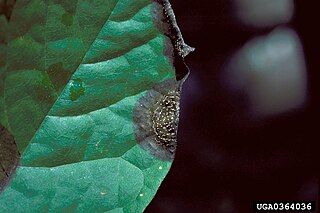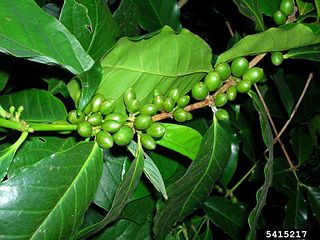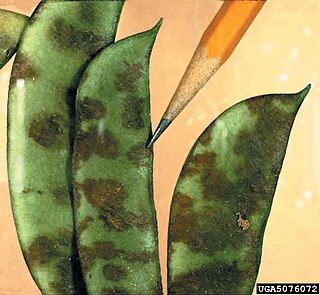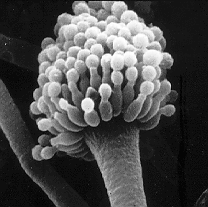
An arbuscular mycorrhiza is a type of mycorrhiza in which the symbiont fungus penetrates the cortical cells of the roots of a vascular plant forming arbuscules.

Epichloë is a genus of ascomycete fungi forming an endophytic symbiosis with grasses. Grass choke disease is a symptom in grasses induced by some Epichloë species, which form spore-bearing mats (stromata) on tillers and suppress the development of their host plant's inflorescence. For most of their life cycle however, Epichloë grow in the intercellular space of stems, leaves, inflorescences, and seeds of the grass plant without incurring symptoms of disease. In fact, they provide several benefits to their host, including the production of different herbivore-deterring alkaloids, increased stress resistance, and growth promotion.
Glomerella graminicola is an economically important crop parasite affecting both wheat and maize where it cause the plant disease Anthracnose Leaf Blight . Certain cereal varieties that have been genetically engineered. may be more susceptible to the teleomorph phase of the fungus.

Colletotrichum acutatum is a plant pathogen. It is the organism that causes the most destructive fungal disease, anthracnose, of lupin species worldwide. It also causes the disease postbloom fruit drop on many varieties of citrus, especially Valencia and navel oranges in Florida.

Colletotrichum kahawae is a fungal plant pathogen that causes coffee berry disease (CBD) on Coffea arabica crops. The pathogen is an ascomycete that reproduces asexually. The asexual spores (conidia) are stored within acervuli. This disease is considered to be one of the major factors hampering C.arabica production in the African continent, which represents the current geographic range of the fungus. Coffee berry disease causes dark necrosis in spots and causes the green berries of the coffee to drop prematurely. High humidity, relatively warm temperatures, and high altitude are ideal for disease formation. Given the severity of the disease and the lack of effective control measures, there is great concern that the fungus may spread to other coffee producing continents, such as South America, which could have catastrophic consequences.
Colletotrichum capsici is a species of fungus and plant pathogen which causes leaf blight on Chlorophytum borivilianum, basil, chickpea and pepper as well as dieback in pigeonpea and anthracnose in poinsettia.

Colletotrichum coccodes is a plant pathogen, which causes anthracnose on tomato and black dot disease of potato. Fungi survive on crop debris and disease emergence is favored by warm temperatures and wet weather.

Glomerella cingulata is a fungal plant pathogen, being the name of the sexual stage (teleomorph) while the more commonly referred to asexual stage (anamorph) is called Colletotrichum gloeosporioides. For most of this article the pathogen will be referred to as C. gloeosporioides. This pathogen is a significant problem worldwide, causing anthracnose and fruit rotting diseases on hundreds of economically important hosts. Laid out here is an overview of some of the most important aspects of this pathogen.

Colletotrichum is a genus of fungi that are symbionts to plants as endophytes or phytopathogens. Many of the species in this genus are plant pathogens, but some species may have a mutualistic relationship with hosts.
Colletotrichum cereale is a plant disease (fungus) that has been found to cause crown rot anthracnose of turf grass most commonly occurring on golf courses. Anthracnose can occur as both a foliar blight and basal rot. This disease attacks the crowns of plants, which is different than other anthracnose diseases. Anthracnose of turfgrass can be a foliar disease or in this case a basal rot of the lower portion of the plant. It attacks different species of turfgrass throughout the world most commonly annual bluegrass and creeping bentgrass.

The fungi imperfecti or imperfect fungi, also known as are fungi which do not fit into the commonly established taxonomic classifications of fungi that are based on biological species concepts or morphological characteristics of sexual structures because their sexual form of reproduction has never been observed. Only their asexual form of reproduction is known, meaning that these fungi produce their spores asexually, in the process called sporogenesis.
Pecan anthracnose is a fungal disease of pecan trees caused by the ascomycete Glomerella cingulata (Stoneman) Spauld. & H. It is a widespread disease found wherever pecan trees are grown. Pecan anthracnose has been reported as far back in time as 1914, and as far away as Argentina. Glomerella cingulata has two anamorphs which cause disease on pecan trees, Colletotrichum gloeosporioides and Colletotrichum acutatum. The occurrence of Colletotrichum on pecans has contributed to a significant decline in pecan production in various years. An increase in the incidence of pecan anthracnose is highly correlated with heavy rainfall, especially heavy rainfall occurring in early spring. The severity of symptoms increases as the season progresses, often culminating in leaf drop in the late autumn. This defoliation is linked to lower yield and poorer quality of nuts.
Colletotrichum somersetense is a morphologically cryptic species described by J.A Crouch in 2014. This species belongs to Colletotrichum caudatum sensu lato and is a pathogen on warm-season grasses. Presence of a unique filiform appendage at the apex of the conidium is the distinctive morphological character.
Colletotrichum hanaui is a falcate-spored graminicolous plant pathogenic fungi species, first isolated from warm-season grasses.
Colletotrichum nicholsonii is a falcate-spored graminicolous plant pathogenic fungi species, first isolated from warm-season grasses.
Colletotrichum paspali is a falcate-spored graminicolous plant pathogenic fungi species, first isolated from warm-season grasses.
Colletotrichum jacksonii is a falcate-spored graminicolous plant pathogenic fungi species, first isolated from warm-season grasses.
Colletotrichum miscanthi is a falcate-spored graminicolous plant pathogenic fungi species, first isolated from warm-season grasses.
The Pyriculariaceae are a family of ascomycete fungi in the order Magnaporthales. It was introduced by S. Klaubauf, M.H. Lebrun & P.W. Crous in 2014.
Colletotrichum coffeanum is a species of fungal plant pathogen affecting mainly the species Coffea arabica and occasionally other species of the genus Coffea. Upon infection, the pathogen can cause coffee berry disease (CBD) which is also known as Brown Blight when it occurs on younger fruits still green in color. The fungus was first reported in Kenya in 1922, and is found throughout most of Africa. C. coffeanum is only found in Africa, but other species of Colletotrichum can be found throughout the rest of the world.







